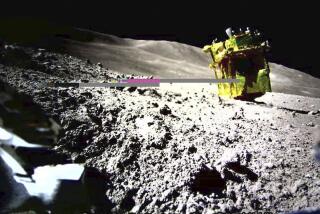Probe Enters Mars Orbit
- Share via
After a seven-month, 310-million-mile journey, NASA’s Mars Reconnaissance Orbiter executed a risky braking maneuver Friday, slipping into an elongated orbit around the Red Planet that should eventually allow it to record the surface in unprecedented detail.
“It’s right on the money!” cheered one mission controller at the Jet Propulsion Laboratory in La Canada Flintridge after confirming the craft survived a 27-minute engine burn.
The orbiter’s safe arrival was a relief to NASA officials, who have seen one out of every three probes launched toward Mars crash or burn up in the planet’s thin atmosphere.
“We’ve only had about a C average for getting into orbit” around Mars, said Doug McCuistion, director of NASA’s Mars Explorations Program.
The craft joins five other missions now at Mars: NASA’s two rovers and the Mars Odyssey and Mars Global Surveyor orbiters, and the European Space Agency’s Mars Express.
The $450-million Mars Reconnaissance Orbiter, or MRO, built by Lockheed Martin Corp. in Denver, is expected to return more data than all previous Mars probes put together.
If all goes well, the craft will settle into its final polar orbit in six months and begin snapping high-resolution images of the planet’s surface.
“This spacecraft is going to rewrite the science textbooks on Mars,” said James Graf, the Reconnaissance project manager.
The 2-ton, school bus-sized probe carries the largest telescope ever launched beyond Earth orbit and researchers hope it will provide surface pictures of unusual resolution and clarity, capturing images of items as small as a foot across.
Scientists believe it might even provide pictures of NASA’s two rovers, Spirit and Opportunity, as well as the crash sites of failed missions, such as the European Space Agency’s lost Beagle 2 probe.
MRO has been cruising toward Mars at about 7,000 mph since its launch from Cape Canaveral Air Force Station in Florida on Aug. 12, 2005. As it entered Mars’ gravity well Friday morning, it accelerated to more than 11,000 mph.
The onboard computer fired the craft’s six engines at 1:24 p.m. PST, initiating a burn that consumed 230 gallons of fuel and slowed the craft by 2,200 mph.
The last six minutes of the burn were carried out after the orbiter had gone behind Mars, out of sight of Earth.
Engineers at JPL waited anxiously until it emerged from Mars’ shadow on schedule at 2:16 p.m. and NASA’s Deep Space Network system’s antennas picked up its signal again.
A few moments later, navigators gave the confirmation: “Mars Reconnaissance Orbiter is in orbit around the planet Mars.”
The orbital insertion maneuver was considered one of the most critical phases of the mission. NASA lost two orbiters -- the Mars Observer in 1993 and the Mars Climate Orbiter in 1999 -- during that phase.
“It’s clear we learned from our mistakes,” said Colleen Hartman, deputy associate administrator at NASA.
The craft entered a highly elliptical orbit ranging from a low point of 264.5 miles above the planet’s surface to a maximum of 28,000 miles.
Beginning at the end of March and continuing for five to seven months, the craft is to carry out a procedure called aerobraking, dipping into Mars’ atmosphere 550 times to be slowed by friction. Ultimately, it would enter a two-hour polar orbit at an altitude of 190 miles.
Once the craft is in its final orbit above Mars, its high-resolution camera should allow scientists to view large rocks that could endanger future landings, enabling them to choose less risky potential sites.
A smaller imaging spectrophotometer is to survey the surface in infrared and ultraviolet light to identify minerals, especially those that might be associated with water.
Another camera, called the context camera, is to take black-and-white pictures of a 20-mile-wide swath to identify sites where high-resolution imaging would be conducted.
The Mars color imager is to capture daily global views of the atmosphere and surface to provide weather maps, track surface changes and identify the composition of clouds.
The Mars climate sounder is to study water vapor, dust, ice and atmospheric temperatures.
The final instrument is a ground-penetrating radar that would look for ice.
The orbiter is also to serve as a high-speed transmitter, relaying data from other Martian missions, including the Phoenix Mars Scout, scheduled for launch in 2007.
The craft was designed to operate in Martian orbit until 2010, but engineers said it had enough fuel to continue through 2014.
“Now we have a permanent scientific presence on another planet,” said JPL director Charles Elachi.
More to Read
Sign up for Essential California
The most important California stories and recommendations in your inbox every morning.
You may occasionally receive promotional content from the Los Angeles Times.













